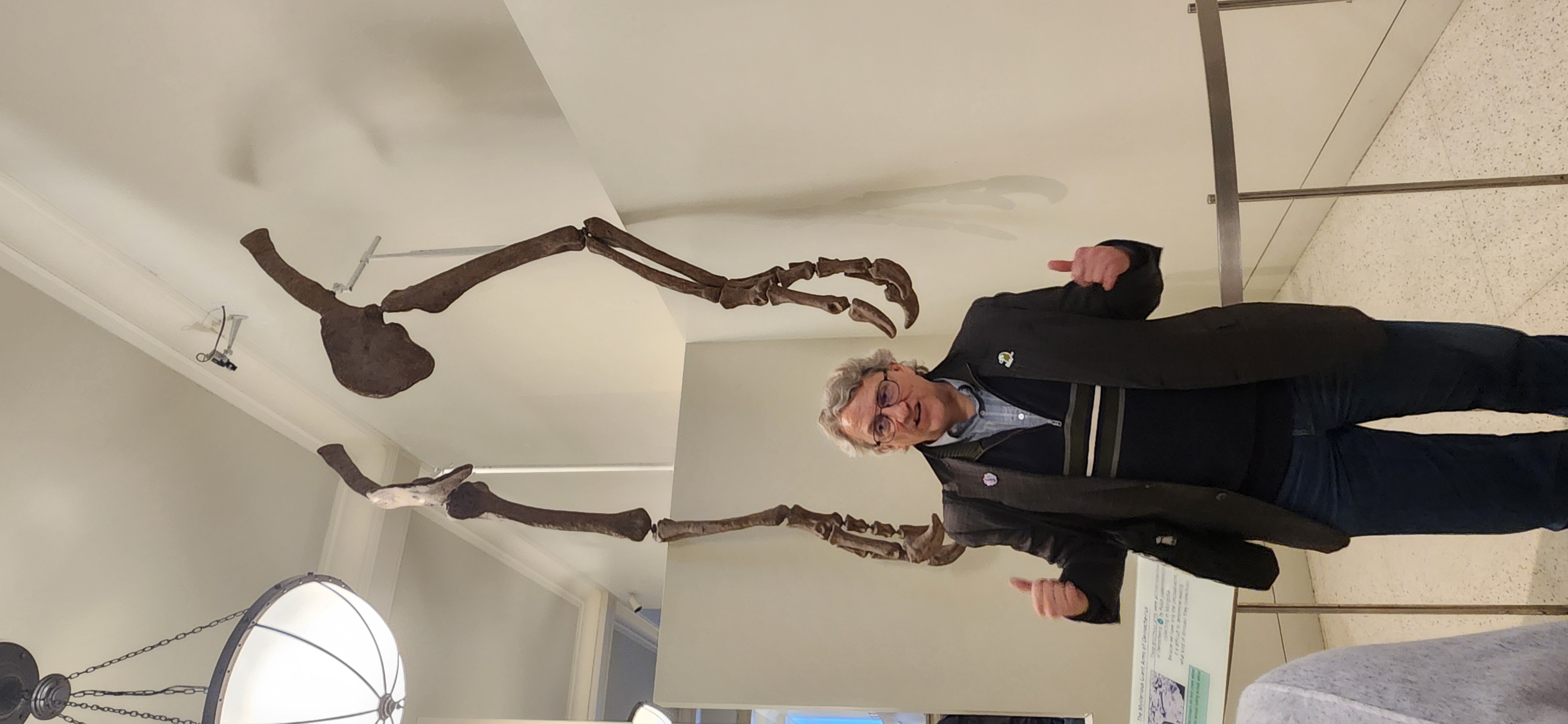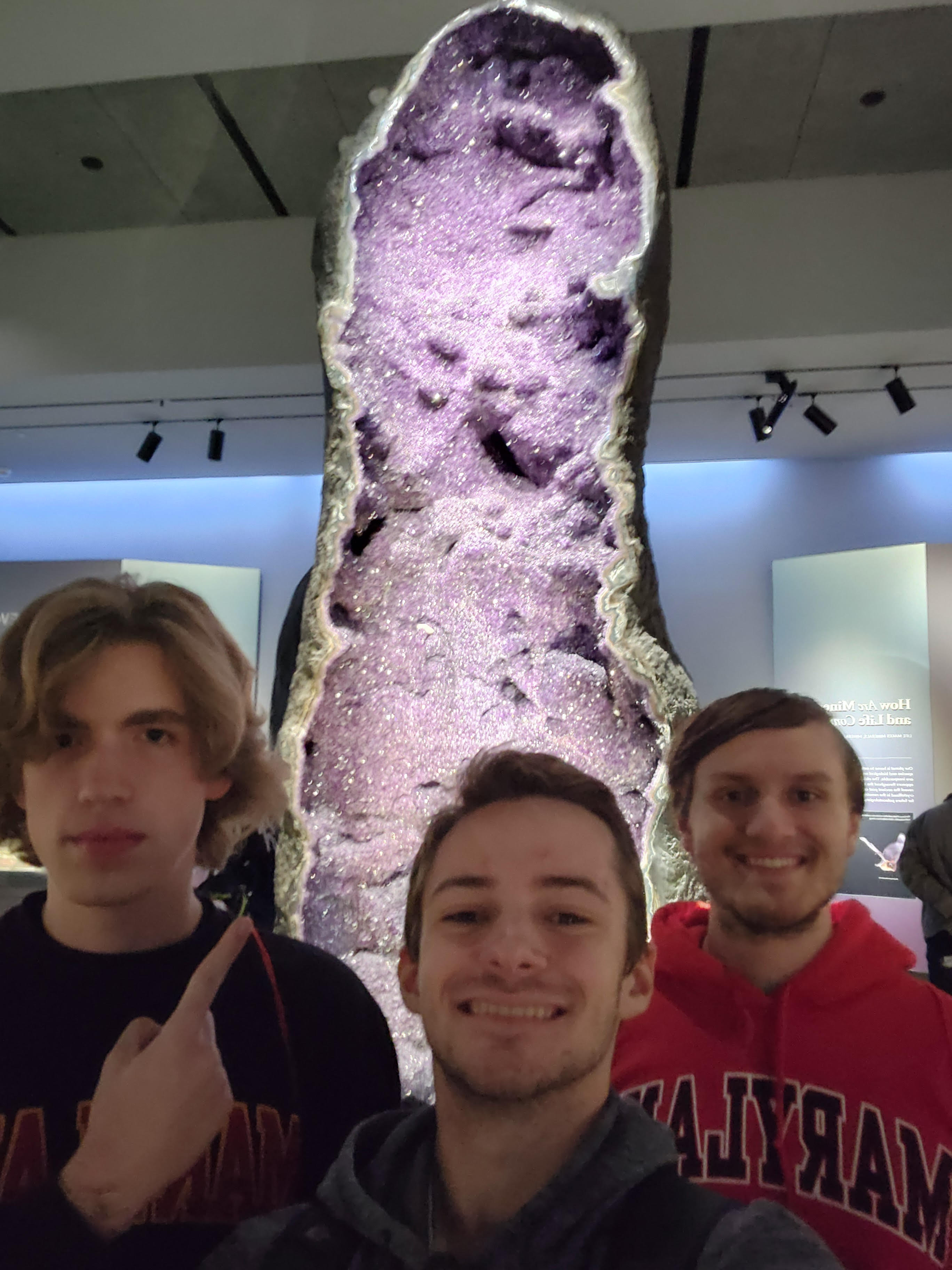American Museum of Natural History Excusion and Worlds Beyond Earth Space Show
November 16th, 2024, at the American Museum of Natural History
On November 16th, 2024, I went on a trip with the Science and Global Change College Park Scholars program to the American Museum of Natural History in New York City. There I went on multiple tours with staff members and one individual tour with some friends exploring various aspects of the museum galleries that were scattered around the museum. I went on two tours that had tour guides, one with Dr. Holtz and one with Dr. Merck, covering the various ages of dinosaurs and their evolution and the evolution of marine life and other terrestrial and aquatic organisms early in Earth’s history respectively.

Dr. Holtz in front of the arm bones of the large Sauropod
On the tour with Dr. Holtz, we talked extensively about the organization of the hall, and how it was designed similarly to a cladogram. A cladogram is a model that depicts the most recent common ancestors of similar species, and resulted in each organism being placed in the museum near where all of their similar species are. Additionally, aspects of the phylogenetic tree were also included in the mapping of the halls, as organisms were sorted based on the time frames by which they originated instead, resulting in the halls having specimens moving in chronological order as you progressed through the tour. Dr. Holtz's tour was primarily about dinosaurs, and I found it incredibly interesting how the scale of raptors in pop culture are completely different compared to their original size. Raptors in popular media like Jurassic Park are the scale of entire humans in the movies, whereas in actuality they were only a foot or two tall, which I thought was fascinating, as such a monumental discrepancy between the two seems unlikely to happen. Additionally, I found it very interesting how they found the set of arm bones of the large Theropod dinosaur, but never found the rest of the fossils. I was curious as to what the final size of the dinosaur would have been, and would love to see what it actually looked like. Lastly, it was explained to me that there was an issue regarding the naming descriptions of a large Sauropod dinosaur, which if I recall was described as a Diplodocus. The issue regarding the name of this dinosaur is that it was not actually a Diplodocus, but a completely new unknown species of dinosaur that simply shared traits with other Sauropods, and was named incorrectly. In order to make the exhibit more accurate and up to date, this specific fossil would need to have its name removed and be identified as it actually is, or rather its lack of identification.
The tour with Dr. Merck was very similar to the tour with Dr. Holtz, but we talked about a completely different segment of the phylogenetic tree, that being early marine life and reptiles. The halls that held these organisms were far more chronologically designed than those of the dinosaur fossils, and were organized by groups of creatures that evolved at similar times, and those that were genetically similar to one another. We found an interesting error in the layout of the museum regarding the placement of turtle ancestors in the hall, as they were given an incredibly prominent and early position in the hall’s layout. While turtles are very impressive and cool to look at and study, the evolution of turtle ancestors and modern day turtles were not a critical or monumental step when looking at the evolution of marine life from an outside perspective. Turtles were not a keystone species when it came to the further evolution of marine life, and mostly stayed to themselves and evolved into the modern turtles and tortoises that we see around the globe today. In order to fix the problem that this placement creates, the turtles would need to be moved further back in the hall where they properly began to appear in history, and they should have a less prominent position in the hall given their lesser impact on the evolution of all marine life compared to the other prominently displayed organisms in the hall. During the tour I found a specific specimen that I found very interesting, called the Mastodonsaurus giganteus. This specimen interested me as I loved how it looked similar to modern day frogs while still having unique body proportions that are nothing compared to the appearance of modern day frogs. I enjoyed taking photos of the model they had on display, and would love to go back and learn more about this species and how it fits into the greater phylogenetic tree. I was additionally intrigued as to why flying dinosaurs or pterosaurs were included in the exhibit hall we visited. I was fascinated by the explanation of the relationship between pterosaurs and other marine life, and how they were genetically related to one another despite occupying vastly different niches in the environments where they once lived. I was shocked to see such a drastic change in the environment, structure, and behaviors of these organisms as compared to those that came before them, despite being proven to have a significant evolutionary correlation to one another.

Me and my friends standing in front of the Giant Geode
On the individual tour that I took with a few friends of mine in the class, we visited the Allison and Roberto Mignone Halls of Gems and Minerals, exploring the various gems and crystals they had on display in the hall itself. The hall had many of its artifacts displayed with those of similar size, similar composition and mineral construction, and similar locations of discovery. Similar types of gemstones were collected with one another, similar sized gemstones were collected together, and there were subsections of similar gemstones from places around the world. Additionally, there was a separate display of gemstones found on royal jewelry and artifacts from around the world, which was very interesting to explore and observe. We looked at three of the larger exhibits they had in the hall, including the Labradorite Pillar, The Singing Stone, and the Giant Geode. Each of these objects were from Fotadrevo, Madagascar, Bisbee, Arizona, and Arigas, Uruguay respectively. These objects were all beautiful and anomalies compared to other minerals and objects of similar composition, as many of the other specimens recovered were not of similar size or luster as compared to those that were on display. Although each of these objects were incredibly cool and intriguing to look at, I would have enjoyed more of the story behind them and their discovery, and depictions of them in the environments that they formed in initially. Looking at them in the museum was still interesting, but all of the gemstones in the exhibit felt disconnected from the natural world, and I would have loved to see photos and stories behind their discoveries and the process of excavating them.
I would also like to briefly talk about the Space Show that we had the treat of viewing while we were there, which was called Worlds Beyond Earth. This show focused on exploring the other worlds of the solar system, particularly those that are most likely to have life on or below their surfaces. The show explored in great detail worlds like Venus, Mars, Europa, Titan, and Enceladus, which all had some relation to the past and future of Earth or had the possibilities of life somewhere on their surfaces. The projections that were shown were very clearly factual and based upon scientific data, as they included observations from various missions to planets that actually happened (Cassini and Juno missions to Saturn and Jupiter respectively) and even used footage from these missions, such as the descent to Titan of the Huygens lander. I didn’t really learn any new information from this planetarium show, as I am an Astronomy major at the University of Maryland and spend most of my time researching events such as these and their impacts on our understanding of the universe. I still greatly enjoyed the show, and it was one of my favorite parts of the trip.
The American Museum of Natural History is designed for all audiences, whether they are young or old, and exhibits are designed to cater for people of all ages as well. Exhibits have large viewing areas and higher observation platforms to allow for kids and those in wheelchairs to still look at the large exhibits that are featured, and interactive segments of the displays make it easier for children to interact with and understand the exhibits. Additionally to these features, many of the auditory or visual experiences in the museum featured both audio and visuals for those who may be audibly or visibly impaired, making it so that all people can enjoy the educational quality of the museum and its exhibits.


